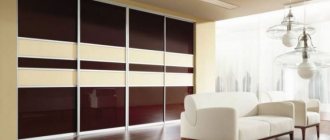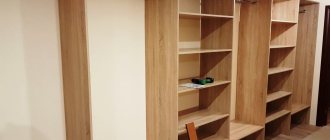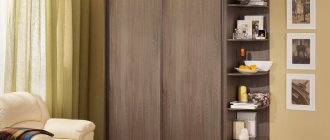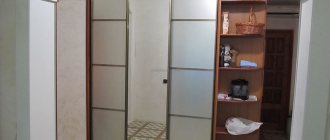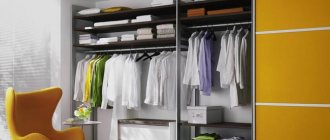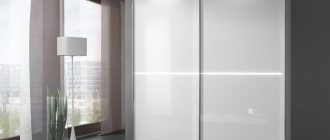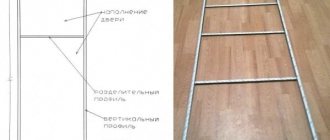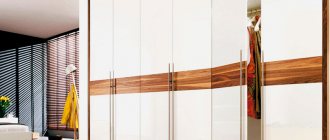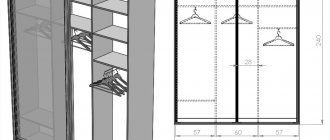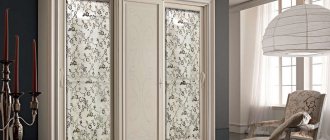Storage organization is always individual: the number of people in the house, their age, tastes, and lifestyle characteristics create completely different needs. In this article we talk in detail about popular options for filling a wardrobe - a universal and spacious storage system. We also analyze ideas for different rooms.
We talked about the stages of planning a storage system in a video
Filling principles
Despite the fact that there are no uniform standards when organizing the internal filling of a cabinet, before creating a project, experts recommend first of all taking into account three fundamental factors:
- location;
- individual preferences;
- available area.
As already mentioned, the specific features of the internal content of the structure are directly influenced by the location, since it is the purpose of the room that determines the nature of the things stored. For example, inside the wardrobe in the hallway there will be outerwear and shoes, in the bedroom - bed linen and household items, in the nursery - toys and school supplies.
It is worth paying attention to the personal preferences of users: having a hobby (drawing, sewing...), specific items in the wardrobe, a large amount of cosmetics, jewelry, a collection of watches, belts, ties and other accessories requires the creation of separate functional areas and the introduction of appropriate elements into the design.
Free area is another important parameter, since it directly affects the size of the body and the main structural characteristics of the structure, which in turn determines the possibility/impossibility of using some functional elements. For example, with a cabinet depth of 300 mm, taking into account the thickness of the sliding system, the useful depth will be slightly more than 200 mm, which makes the installation of longitudinal rods pointless.
Installation
Mark the points where the shelf will be located.
Important! When making markings, strictly observe horizontal levels. Otherwise, the load on the shelf will be distributed incorrectly and the fastening may break.
Using a level, check that the side walls of the cabinet are at right angles to the back wall.
Sequence of work:
- Using a drill, holes are drilled according to the markings.
- Install shelf holders.
- The shelf is installed on the selected mounting option.
To strengthen the structure, use bars made of the same material as the shelf. The parts are fixed to the front edge using wood glue or screws.
Advice . If the shelf is successfully made, you can proceed to the cabinet doors.
Zoning
Also, it is important to understand that when creating a wardrobe design for the most comfortable operation, the internal space (at least in classic designs) must be divided into three functional zones:
- top;
- main (average);
- lower
This division allows you to use the internal space with the greatest efficiency, since zoning eliminates overload of individual elements, helps maintain orderliness of things and eliminates inconvenience during everyday use.
According to the rules for organizing storage systems, the upper part of the furniture (mezzanine) is a hard-to-reach place and is intended for the least needed items - seasonal clothing, light sports equipment, bedding.
The distribution of the middle section of the closet is based on the fact that the most used things will be located here, since this section is more convenient to use. This is where shelves for storing casual clothes (T-shirts, jeans...), rails for delicate work clothes (jackets, shirts, trousers, skirts), baskets for underwear and compartments for accessories should be located.
Using the lower part of the structure is also comfortable and accessible for most people, so secondary, but no less in demand, things are located here, as well as the most bulky and heaviest items. There are usually shelves for storing shoes, drawers with knick-knacks, home and clothing care equipment (vacuum cleaners, irons, ironing boards), household cleaning chemicals, etc.
Pull-out shelves
If you decide to make a pull-out shelf in your closet, then in addition to all of the above, you will need to use a special mechanism on which the shelf will move. You can purchase such a device at furniture stores, or you can remove it from an old chest of drawers, cabinet or computer desk, if the size is suitable. In order not to make mistakes with the calculations, be sure to draw up a drawing of the future shelf.
First, we make the shelf itself from wood or chipboard. If you decide to make a drawer instead of a sliding shelf, then you will have to add three more walls: two side and one front, as well as a handle. Be sure to take into account the dimensions of the mechanism itself when calculating, since it will be mounted on the end of the shelf and the inside of the cabinet. As a rule, its dimensions range from 4 to 6 centimeters in width. Fastening occurs using a large number of small screws.
As you can see, at home you can make almost any shelf of absolutely any size. To do this, you do not have to have special carpentry skills, but simply draw up a competent drawing and select good fasteners. After this, installation is reduced to minimal theoretical knowledge. However, this does not mean that this process should not be approached with great responsibility, because if the shelf is not secured securely, then it will simply not be possible to store objects with a large weight on it. Therefore, use only high-quality screws and a reliable screwdriver.
Functional elements
Since the wardrobe is a permanent structure and is intended for long-term use over many years, it is important to carefully consider the composition of its equipment. The modern market offers a wide range of high-quality retractable and stationary functional elements to suit any need.
Due to the low cost, basic configurations are usually equipped to a minimum - only stationary shelves, drawers on roller guides and longitudinal rods for hangers will be installed in the furniture. This set satisfies the needs of most owners, but does not allow the full potential of the design to be revealed. Therefore, in order for the filling of the wardrobe to bring maximum benefit, you must be prepared for additional costs for the installation of auxiliary functional elements.
Among the most popular standard devices are:
- Pantograph (furniture elevator). A mechanism that allows you to lower the horizontal bar to the required level.
- Mesh baskets (pull-out, stationary). Metal wire baskets for storing clothes and shoes.
- Linen baskets (with fabric bag). Designed for storing used and dirty linen.
- Transverse (end) hangers. Typically used in narrow structures when using a classic rod is impractical.
- Spiral hangers. Screw design for more organized storage.
- Carousels for hangers. Rotating mechanism for attaching hangers.
- Trouser holders. A retractable or stationary mechanism with several small rods/hangers for storing trousers.
- Drawers with cells. Drawers with dividers for storing accessories, jewelry, organizers or underwear.
- Cascading shoe racks. A system of several inclined shelves with mesh or anti-slip coating.
- Built-in ironing board. Folding one-piece or retractable folding ironing board.
Also, depending on personal preferences or wishes, highly specialized holders/baskets can be made to order for storing household appliances, televisions, collections of accessories, toys, hobby items and any other things.
Making a wooden shelf
Finally we get to the manufacturing process itself. To make a wooden shelf in a closet, you will need to collect all the necessary tools in one place in advance, so that during the process you will not need anything. Typically the list will be something like this:
- a regular iron for gluing furniture wool;
- drill with drills of suitable size;
- stationery knife and pencil;
- fasteners.
You will also need to get an electric jigsaw or circular saw if you decide to cut the boards yourself.
The workpiece must be cut only according to a pre-drawn diagram (drawing). It is best to do this with a saw, since the jigsaw may leave uneven surfaces that will have to be sanded down. You can also contact a carpentry workshop, where they will cut boards of the required size for you for a small amount.
The ends should be covered with furniture edges so that moisture cannot penetrate into the material. Edge tape is best applied using a hot iron. To cut off the excess, you need to use a utility knife or sandpaper. After that, all that remains is to install the shelf in the closet.
Rules for internal filling depending on location
Depending on the location of the wardrobe, the design of the internal filling will differ significantly from room to room, therefore, in order not to “reinvent the wheel” from scratch each time, there are certain rules that take into account these features, and on which, subsequently, it is necessary to apply individual schemes placing things.
For the hallway
For a hallway, a wardrobe is the most successful solution when organizing a storage system, since the sliding door mechanism provides free passage in a limited opening, and if there is a niche, you can create a full-fledged dressing room.
The internal filling of the closet must necessarily contain modules for storing outerwear, shoes and accessories. If possible, open corner shelves are additionally installed for various small items.
The upper part of the structure is reserved for storing rarely used and seasonal items, shoe boxes, suitcases, travel bags, etc.
In the middle part, at an accessible height, longitudinal and transverse rods for hangers are installed; in high structures, a pantograph is mounted, which allows you to easily lower the top rows of clothes. If necessary, holders for umbrellas, hats, and keys are added.
Closer to the floor, wire mesh baskets are installed for storing shoes, shelves for care products, and space is allocated for household appliances and tools.
It is important to note that it is recommended to use a mirror as a sliding door leaf, as it allows you to evaluate your appearance and quickly correct any deficiencies found.
For the bedroom
The bedroom is the most important room for every person, as it is a place of privacy, relaxation and sleep. At the same time, this room is a “storage room” for a large amount of clothing and various accessories that are not desirable to be put on public display. Therefore, in order not to clutter up the existing space, as well as to get rid of existing visual and physical trash, it is necessary to properly plan the storage system.
A spacious wardrobe for the bedroom is a real godsend, as it allows you to distribute all the available things in their own corners and free up your living space as much as possible.
The upper section of the closet should be used to place bedding - pillows, blankets, blankets, spare sets. There are also old bags, boxes with personal belongings, formal shoes that are worn for special occasions no more than a couple of times a year, and other rarely used items.
In the main part, casual clothes, pajamas, bathrobes, and towels should be stored on the shelves. Underwear and underwear are stored in drawers, separately for men and women. Delicate items - shirts, pants, skirts, dresses - are placed on hangers. You can place accessories, ties, watches, and documents in separate compartment sections. If necessary, the design can also be equipped with a folding or retractable ironing board.
The lower part is usually used to store the most bulky items - household appliances, boxes with mixed contents, hobby supplies.
For children's
A children's room is a multifunctional room that combines a bedroom, an office, and a playroom. A child’s room should not only have a special color and atmosphere of joy, but also provide space for active recreation, study and creativity, as well as ensure safety in all its manifestations, including when using furniture.
Since a wardrobe is purchased for more than one year, the design of the internal contents must be developed carefully, taking into account the age and gender of the child, subsequent growing up, and certain interests and hobbies. It is also important to hear his own suggestions in this regard.
The upper part of the structure will most likely be inaccessible to the child, so bedding, seasonal clothing, items for themed events and other items that are not useful in everyday activities should be placed in it.
When using the main section, the child should not make any effort to get the necessary item, otherwise there is an increased likelihood of injury - all items must be within reach. In this situation, it is most important to use a pantograph for easy access to high longitudinal rods on which jackets, shirts, trousers, and skirts will be stored.
Shelves below eye level can be used to store knitwear and underwear, while shelves higher can be used for hats and outdoor accessories. There must be a compartment for toys and creative supplies; a separate section can be allocated for fiction, textbooks, notebooks and stationery.
The lower tier is necessary for storing clean indoor and outdoor shoes, sports equipment, and large toys.
It is also important to take into account the manufacturing features of the structure - all corners must be edged with PVC edges, and the glass must be made using triplex technology or covered with a protective film to prevent the appearance of splinters. However, despite the complex of protective measures, experts still recommend abandoning the use of pull-out shelves in favor of baskets and plastic boxes when there are preschool children.
Screw tie
Another common type of screed, which is actively used when making shelves in a closet with your own hands. To fasten the shelf, a screw and a special barrel are used, which connect the shelf to the cabinet wall. It is worth noting that such a mechanism is highly complex to install, so if you are not confident in your abilities, it is better to ask a professional for help. The main problem is the difficulty of aligning the hole in the shelf with the barrel. However, the screw tie guarantees a reliable connection and a long service life.
Filling a wardrobe with dimensions - examples
All images are clickable.
Width ≤2 meters
Width ≤3 meters
Corner
Built-in
By number of doors
Contact the Promir furniture factory for the manufacture of sliding wardrobes in individual sizes - we guarantee high quality and optimal prices.
Corner screed
Special furniture corners can be made of wood and plastic. Installation of such parts does not require special knowledge and skills. It will be enough to use a screwdriver and several self-tapping screws to connect the shelf to the side wall of the cabinet. The only difficulty may be the correct location of the corner ties relative to one axis. If you create an uneven structure, then such a shelf will be of little use.
Options for design and decoration of facades
The first steps have been taken: the material and configuration have been selected, and the internal content has been determined. All that remains is to decide on the design and facades. The budget option consists of solid facades made of wood chipboard. Many designers advise combining chipboard with mirror elements, which visually increase the interior space of the room, hiding some construction flaws.
Designers identify five main options for facades:
- classic style - the facade is decorated with chipboard. One of the two (three) doors can be decorated with mirror glass;
- The diagonal façade is characterized by the presence of metal profiles that conventionally divide the surface into parts. In this case, the profiles are located at an angle to each other. Any option can be used as a finishing material: chipboard sheets of various shades, painted/transparent glass, mirror;
- geometric style - cabinet doors are decorated with rectangles of different heights, but the same width corresponding to the width of the door. As in the previous version, any material can be chosen for finishing;
- wave style is the most expensive decorative element, since the plates are made individually. At the same time, the wave style allows the owner of the headset to show creativity;
- sectorial facade - the source material is divided into tiles of a certain size and placed on the surface of the cabinet in the order specified by the customer/designer.
Modern technologies for the production of finishing materials have advanced so much that the number of design solutions is in the thousands. Let's look at the most common ones:
- Chipboard is the most modest decor option. The wood panel emphasizes the simplicity of the style, creating the effect of invisibility of “bulky furniture”, while the color solutions are so varied that it is quite possible to hide the simplicity of the interior. Advantages of finishing: ease of maintenance, resistance to mechanical damage, durability;
- mirror - a 2-meter cabinet, standing in a small room, whose doors are decorated with mirror glass, visually enlarges the space. Amalgam leaves an indelible impression of beauty, but requires constant care, since even the slightest dirt (fingerprints) is noticeable on the surface;
- frosted glass is a durable, translucent material. It is the effect of transparency that is not entirely appropriate for decorating cabinets in the hallway or living room. Furniture in this design would be more appropriate in a bedroom, since the contents of the closet are partially visible through the matte surface;
- doors made of glass, the inside of which is coated with colored varnish, look impressive;
- glass surfaces with drawings/photos. Here it is possible to show limitless imagination. The technology for producing such surfaces allows you to give the appearance of any texture (natural wood, gloss, natural stone, relief sketch, landscape).
The most expensive decor options include finishing with natural wood and leather, but, as a rule, such decoration is used exclusively in the manufacture of custom-made furniture.
Quartblog Digest
How to arrange wardrobe storage: ideas from the heroes of the Kvartblog - Some of our heroes, whom we visited, managed to separate their dressing room from the general area, while others store things in closets and on special racks.
We've looked at the best options. Wardrobe in a small bedroom - How to store clothes in the bedroom if there is very little space? Kvartblog will tell you about 5 great ideas for a dressing room in a small bedroom.
How to choose your dream wardrobe: personal experience - 5 tips on how to choose the right wardrobe. The quart blog will tell you how to choose the dream scarf that is perfect for you!
10 ways to update the appearance of your closet - If your closet looks shabby, but is still quite functional, this is not a reason to buy a new one!
Life hack: how to save space in your closet - Just a few simple tips will help you free up space in any closet.
filling of cabinets, filling, wardrobe, sliding wardrobe
Installation
All components are manufactured both according to standard design and to order. The first option may immediately fit into the right place, or it may require an individual approach. Then the wardrobe will be made based on the client’s wishes.
As a façade decor, it is better to choose a mirror surface for at least one of the doors.
After using the wardrobe for some time, the layout inside may not meet the comfort standards of an individual family. Then you can modernize the existing filling of the cabinet by adding or removing some elements. To carry out installation, it is enough to have the necessary fittings and a screwdriver. In extreme cases, you can call a specialist.
For installation, special fittings are used - for elements that can be pulled out, doors, rod mounts, lighting, etc.
